INNOVATION IN A POST-COVID-19 SCENARIO | article | Wednesday, January 12, 2022
MIXED ROUTINES, ALTERED USES

The pandemic has completely altered routines and consumption occasions. Moments dedicated to work, training, learning, self-care, entertainment and social life are organized in a more dynamic way than in the past. Days integrate a diversity of activities that are carried out intermittently and simultaneously, a continuous straddling of the blurred boundaries between work and leisure, analog and virtual, public and private. These habits will deepen in the future, which will require designing a new environment that facilitates the execution of mixed tasks, as well as proposing new products and services for hybrid usage occasions.
The pace of life has become more flexible: people have to deal with a heterogeneity of tasks and occupations in the same environment. The design of spaces, furniture and devices will be oriented to create scenarios with variable functionalities and aesthetics that can be quickly adapted to an eclectic agenda. The Smile is an apartment complex in East Harlem designed by BIG (Bjarke Ingels Group), which is equipped with an intelligent modular furniture system. Each apartment is composed of storage cabinets and bed structures that rise and fall according to the daily and changing needs of each resident. When a component is not in use, it is raised and disappears into the ceiling to make room for other activities. A voice command recognition system returns furniture to its original position.
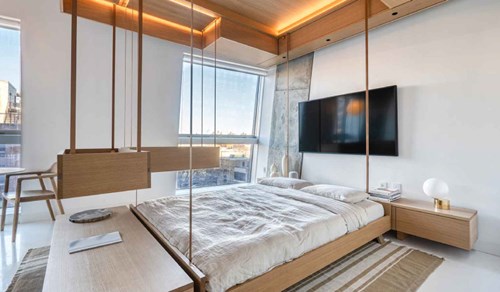
Multipurpose spaces will be necessary to functionally respond to the diversity of tasks that could be executed, simultaneously, by family members or cohabitants: a father could be doing a household chore, the son taking an online class, the daughter doing her training and the mother doing remote work, all in the same environment. The need emerges to design environments that can be synchronously adapted to the different aesthetic, sensory and environmental requirements of each participant. Poly Collection is a line of multipurpose furniture designed by Patrick Norguet and Natuzzi, which responds to the diverse needs of those who work from home and have small spaces. The equipment includes desks, tables and modular dividers, which help reinterpret the shape of domestic spaces. Partitions block sound and create distinct areas for work and leisure.
One of the challenges will be to add well-being features to indoor spaces to improve people’s quality of life during their work routine. The goal is to offer products, services and experiences that facilitate self-care and prevention practices in a simple way. Vitapod is a home beverage system that combines fresh filtered water with plant-based vitamins, minerals and antioxidants to create ‘healthier waters’ that can be drunk throughout the day. The device includes capsules and simple controls to make combinations with fruit flavors without sodium, sugar, artificial flavors or sweeteners. Adding new functional, cognitive and emotional benefits to domestic habitats will be crucial. Space10, Ikea’s experimental design lab, worked with creative audiovisual studio Field.Systems to create the ‘Virtual Oasis’ concept that makes use of augmented reality and spatial audio to provide a guided meditation journey with a more immersive and holistic approach. Thanks to mixed reality, the experience turns familiar scenes into relaxing, mood-enhancing retreats.
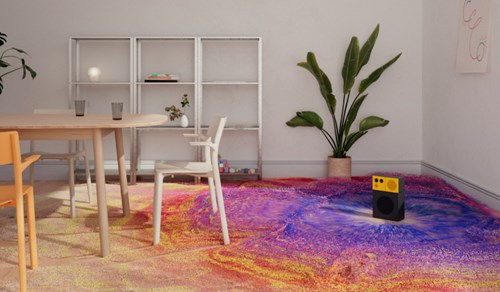
The pandemic unveiled the most fragile side of people and encouraged the exposure of critical feelings, something that had been occurring for some years but has now acquired a massive scale. Expressing one's fears and frustrations is natural and desirable in a context of lingering uncertainty. Days are regularly starting to add useful techniques to manage mental illnesses. The Opus SoundBed, by Yves Beharm, is a foldable therapeutic bed which offers a multi-sensory meditative experience to recharge and restore the nervous system. The surface vibration, combined with spatial sound, helps the body reduce stress by the release of natural hormones associated with happiness and euphoria.
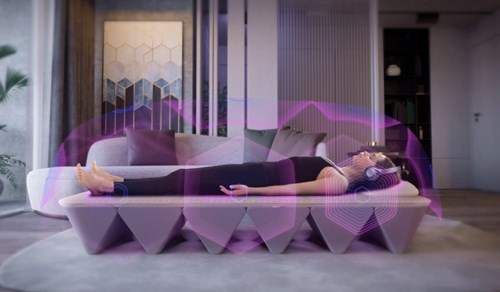
Just as tasks alternate in a more dynamic way and the rhythm becomes more changeable, the usage occasions of products and services also undergo transformations. It is no longer easy to clearly delimit the moments and linearly define the requirements, everything merges to create mixed practices: exercising while doing remote work, having lunch while attending online classes, socializing on social networks while performing a beauty routine. This invites us to think of original product typologies in sectors such as fashion, food, beverages, cosmetics, decoration and furniture, to accompany these hybrid moments that must respond to different needs at the same time. The ‘Sit2Go’ fitness chair, designed by office furniture firm FlexiSpot, provides a comfortable sitting experience that fights sedentary lifestyles by including bicycle pedals to exercise the legs. The chair, made of a breathable mesh fabric, records calories and provides information on physical performance while working. The ‘12 Steps’ stool, designed by HaYoung Yoo, is a sitting solution for professionals or students that integrates a series of handles (like climbing holds) at its base, allowing the feet to be placed in different orientations to encourage movement and body flexibility during working hours.
Not only do instances of use change, but also the environments where traditional activities are performed. The boundaries between inside and outside are blurring: working from home, celebrating a birthday outdoors, playing sports in the parks, taking a course from the bedroom, practicing self-care in the office. It becomes evident to think of products that play and enhance these changes of scenarios so that the new experience provides other stimuli and generates other emotions. ‘Stoke’, designed by DongJae Koo, is an indoor cooking appliance inspired by an outdoor grill, which brings a sense of community to the simple act of inviting friends and family over for dinner. The stove uses charcoal modules that can be moved with a poker, imitating the experience of a conventional grill in an outdoor space where everyone can participate.
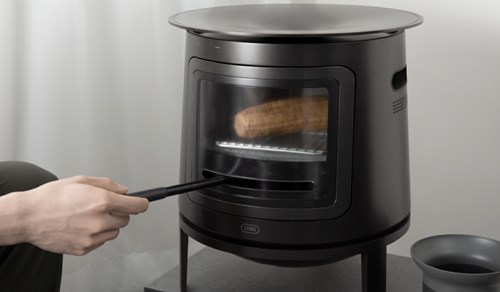
The expansion of hybrid formats of activities integrating analog, digital and virtual instances, provide another color to the routine and require people to have tools at hand to navigate smoothly through these different dimensions. Owl Labs presented ‘Whiteboard Owl’, a new device that allows participants who work remotely to see a high-resolution image of a physical whiteboard in the office. This solution is intended for hybrid work environments, as it allows everyone to add information and view it at the same time in a collaborative process.
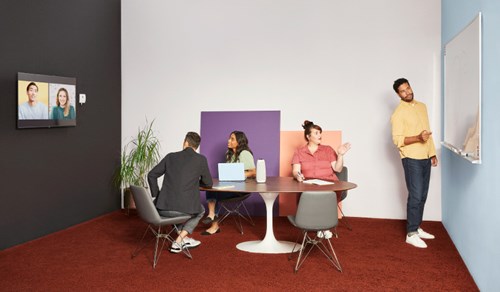
The configuration of a heterogeneous and flexible routine has legitimized a certain informality to perform certain tasks that were previously guided by stricter social protocols. This encourages redefining the criteria with which certain product categories were initially conceived, associated with a specific occasion, which must now be adapted to different spatial and temporal contexts. An unprecedented universe of business opportunities opens up for the different industries that could now design joint offers in a more organic way. Sacha Buliard has designed a mat for those looking to connect more with their mind and body by moving in different ways. The mat, built with eco-friendly foam, incorporates different shapes and textures on the surface to accommodate four main stages of body research including: awakening, balancing, exploring and touching.
Managing a healthy balance between work and personal time becomes a priority when people are busy and online all day. There is an increased pressure to achieve a sensible work routine without sacrificing daily enjoyment. The Blueprint coffee maker has the extra function of helping people to organize their task routines and goals. The system creates a relationship between coffee, energy and productivity. The device is connected to a smartphone to set daily micro-goals, such as going for a run, meditating for five minutes or reading a chapter of a book. Through the app, the coffee maker can be configured from anywhere, as long as water is charged and the coffee is pre-ground and ready to use. Likewise, Yumme is a digital meal kit and meal service concept devised by Hyogyeong Kang, Younghyun Na and Dayoung Lee, designed for people who enjoy healthy, home-cooked meals but lack the time to shop or cook. Dish options vary according to the user’s diet. An alternative is a tray that includes five compartments with different foods for users who want to explore the full spectrum of a balanced diet. Sensors integrated in the tray analyze the content and nutrients of each meal, data that can be read via an app. The app, in turn, allows the diner to connect with other users to share experiences and tips.
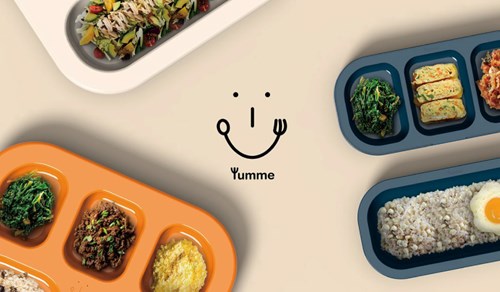
The boundary between public and private life is in the midst of a transformative process as a result of the emerging habits encouraged by the pandemic. During the health crisis, home privacy was abruptly circumvented by the entry of activities traditionally performed outside home, such as work, learning, and training. It was not possible to set the home infrastructure so as to be able to successfully choose and manage the public exposure of home and family: Did we want to show our work colleagues our everyday life with our partner? Did we want all our university classmates to know where we live? Although social networks had already, in part, removed the walls of homes by encouraging the display of one’s personal universe, the truth is that this had been done in a more elaborate way and those who did not agree with the exhibitionist practice had been able to preserve their intimacy. This new intrusion into privacy has a different impact on different generations: younger people, who have grown up with invasive technologies and social networks around them, cope better with the fact of naturally showing corners of their intimate life, while for other people, it implies a certain discomfort.
Architecture and interior design should incorporate solutions to enable people to better manage how much of their intimate and home life they choose to share with others. This becomes an indispensable requirement in space-constrained dwellings. Microsoft Flowspace is an office module that creates a private workspace to help employees escape disruptive noise. It features automated privacy panels, a computer (which takes up almost the entire interior panel), a desk, and a stool. The capsule can be installed at home or within a work environment, and comes in two halves (desk and back) so users can combine them for a place that encourages concentration. Common areas should also consider different options to create a diversity of situations. BuzziSpace introduced Hubs of Togetherness, a line of furniture for hybrid office spaces. The proposal includes seats, armchairs and tables with organic shapes and acoustic (noise-reducing) materials that can be combined and arranged in a variety of ways to adapt to different group sizes without losing intimacy.
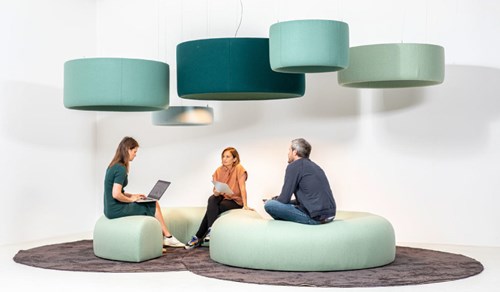
Just as domestic spaces permanently or intermittently host activities that used to take place outside, some indoor practices are also carried out in the open air and in full view of everyone: training sessions, self-care rituals and a variety of celebrations are now part of the urban landscape. This requires devising solutions that respond to these outdoor occasions, while encouraging the development of original products that encourage other experiences in nature. Finnish design firm Upwood and creative agency TBWAHelsinki collaborate to install remote workstations in the middle of nature in the city of Lahti in Finland. The desks, mounted in trees, were placed in forest parks near residential areas, providing a sense of escapism while allowing employees to work productively. The furniture accommodates a laptop, a telephone and other utensils, and is made locally from Finnish spruce wood. For its part, Samsung Cuisine is a concept designed by Ben Sullivan, and consists of a small lunch box-like food carrier that integrates inductive technology to heat the contents up to 300 degrees Fahrenheit. This would allow people to take their favorite food anywhere, facilitating outdoor dining experiences. The device can be used to heat food in the upper section, while the lower part is perfect for keeping it cold.
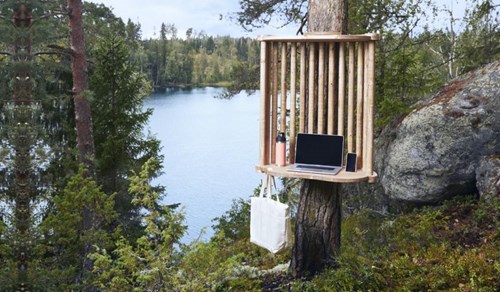
Outdoor activities involve another degree of exposure: Do we want neighbors to see us sweating as we work out in the neighborhood square? Do we care if others know about our wellness routines? ‘Lunit’ is a concept of medical devices designed by Sungchae Park and Dayeon Jang for people who need to perform health tests when they are away from home. The solutions include a blood glucose monitor, inhaler, blood pressure oximeter and insulin syringe. This makes it possible for users to test and monitor their levels outdoors with devices that are friendly and unobtrusive in design. Along the same lines is ‘Esc.’, a public rest space ideal as a temporary refuge from the permanent movement and noise of the city. Designed by Toine Baert of Tew One Design, the installation is intended to rest one’s mind and improve mental health. It includes an armchair partially enveloped in an umbrella-shaped canopy that creates a noise buffer for acoustic, visual and emotionally quiet concealment. Esc. is responsibly made from 100 percent recycled PET felt and durable wood.
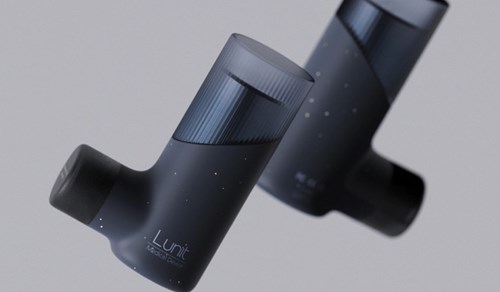
In the post-pandemic scenario, routines, tasks and instances of consumption will become more flexible, which will require the design of products and services beyond traditional categories. The emergence of mixed moments that merge instances of work, training, learning, self-care, entertainment and social life represents an opportunity to design joint offerings that integrate the knowledge of diverse industries. Brands will be able to take advantage of people’s desire to play with the limits and formats of their activities, to offer them original experiences with simultaneous benefits.
